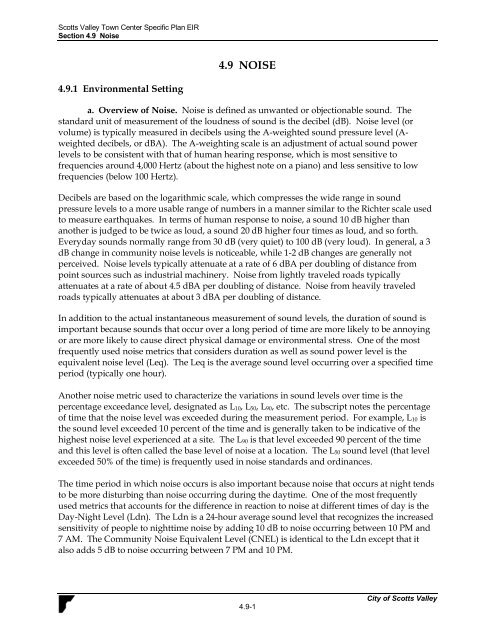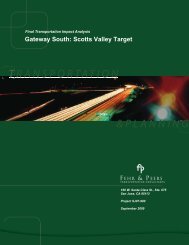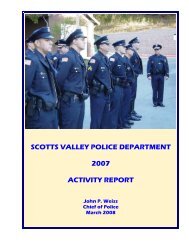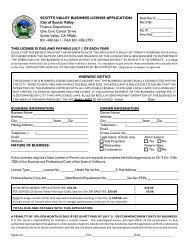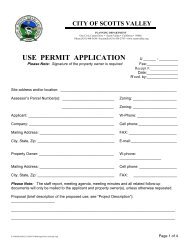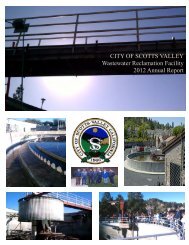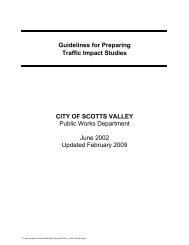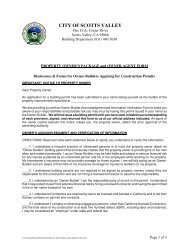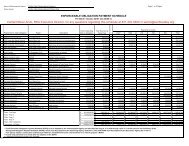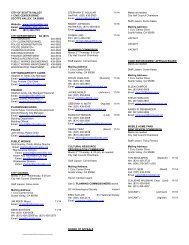4.9 Noise.pdf - City of Scotts Valley
4.9 Noise.pdf - City of Scotts Valley
4.9 Noise.pdf - City of Scotts Valley
Create successful ePaper yourself
Turn your PDF publications into a flip-book with our unique Google optimized e-Paper software.
<strong>Scotts</strong> <strong>Valley</strong> Town Center Specific Plan EIR<br />
Section <strong>4.9</strong> <strong>Noise</strong><br />
<strong>4.9</strong> NOISE<br />
<strong>4.9</strong>.1 Environmental Setting<br />
a. Overview <strong>of</strong> <strong>Noise</strong>. <strong>Noise</strong> is defined as unwanted or objectionable sound. The<br />
standard unit <strong>of</strong> measurement <strong>of</strong> the loudness <strong>of</strong> sound is the decibel (dB). <strong>Noise</strong> level (or<br />
volume) is typically measured in decibels using the A-weighted sound pressure level (Aweighted<br />
decibels, or dBA). The A-weighting scale is an adjustment <strong>of</strong> actual sound power<br />
levels to be consistent with that <strong>of</strong> human hearing response, which is most sensitive to<br />
frequencies around 4,000 Hertz (about the highest note on a piano) and less sensitive to low<br />
frequencies (below 100 Hertz).<br />
Decibels are based on the logarithmic scale, which compresses the wide range in sound<br />
pressure levels to a more usable range <strong>of</strong> numbers in a manner similar to the Richter scale used<br />
to measure earthquakes. In terms <strong>of</strong> human response to noise, a sound 10 dB higher than<br />
another is judged to be twice as loud, a sound 20 dB higher four times as loud, and so forth.<br />
Everyday sounds normally range from 30 dB (very quiet) to 100 dB (very loud). In general, a 3<br />
dB change in community noise levels is noticeable, while 1-2 dB changes are generally not<br />
perceived. <strong>Noise</strong> levels typically attenuate at a rate <strong>of</strong> 6 dBA per doubling <strong>of</strong> distance from<br />
point sources such as industrial machinery. <strong>Noise</strong> from lightly traveled roads typically<br />
attenuates at a rate <strong>of</strong> about 4.5 dBA per doubling <strong>of</strong> distance. <strong>Noise</strong> from heavily traveled<br />
roads typically attenuates at about 3 dBA per doubling <strong>of</strong> distance.<br />
In addition to the actual instantaneous measurement <strong>of</strong> sound levels, the duration <strong>of</strong> sound is<br />
important because sounds that occur over a long period <strong>of</strong> time are more likely to be annoying<br />
or are more likely to cause direct physical damage or environmental stress. One <strong>of</strong> the most<br />
frequently used noise metrics that considers duration as well as sound power level is the<br />
equivalent noise level (Leq). The Leq is the average sound level occurring over a specified time<br />
period (typically one hour).<br />
Another noise metric used to characterize the variations in sound levels over time is the<br />
percentage exceedance level, designated as L 10, L 50, L 90, etc. The subscript notes the percentage<br />
<strong>of</strong> time that the noise level was exceeded during the measurement period. For example, L 10 is<br />
the sound level exceeded 10 percent <strong>of</strong> the time and is generally taken to be indicative <strong>of</strong> the<br />
highest noise level experienced at a site. The L 90 is that level exceeded 90 percent <strong>of</strong> the time<br />
and this level is <strong>of</strong>ten called the base level <strong>of</strong> noise at a location. The L 50 sound level (that level<br />
exceeded 50% <strong>of</strong> the time) is frequently used in noise standards and ordinances.<br />
The time period in which noise occurs is also important because noise that occurs at night tends<br />
to be more disturbing than noise occurring during the daytime. One <strong>of</strong> the most frequently<br />
used metrics that accounts for the difference in reaction to noise at different times <strong>of</strong> day is the<br />
Day-Night Level (Ldn). The Ldn is a 24-hour average sound level that recognizes the increased<br />
sensitivity <strong>of</strong> people to nighttime noise by adding 10 dB to noise occurring between 10 PM and<br />
7 AM. The Community <strong>Noise</strong> Equivalent Level (CNEL) is identical to the Ldn except that it<br />
also adds 5 dB to noise occurring between 7 PM and 10 PM.<br />
<strong>4.9</strong>-1<br />
<strong>City</strong> <strong>of</strong> <strong>Scotts</strong> <strong>Valley</strong>
<strong>Scotts</strong> <strong>Valley</strong> Town Center Specific Plan EIR<br />
Section <strong>4.9</strong> <strong>Noise</strong><br />
b. Regulatory Setting. <strong>Noise</strong> control is regulated through the <strong>City</strong> <strong>of</strong> <strong>Scotts</strong> <strong>Valley</strong><br />
General Plan <strong>Noise</strong> Element and the <strong>City</strong>’s Municipal Code. Section 17.44.020.C.3 <strong>of</strong> the<br />
Municipal Code states:<br />
<strong>Noise</strong>. At the lot line <strong>of</strong> all uses specified in Chapters 17.20, 17.22, 17.24, 17.26 and<br />
17.28 <strong>of</strong> this title, the maximum sound generated by any user shall not exceed seventyfive<br />
dbA when adjacent users are industrial or wholesale users. When adjacent to <strong>of</strong>fices<br />
or retail, the sound level shall be limited to seventy dbA. When users are adjacent or<br />
contiguous to residential, park or institutional uses, the maximum sound level shall not<br />
exceed sixty dbA. Excluded from these standards are occasional noises which are<br />
specifically exempted under Section 5.17.030.<br />
The uses specified in Chapters 17.20, 17.22, 17.24, 17.26 and 17.28 <strong>of</strong> the Municipal Code include<br />
service commercial, shopping center commercial, pr<strong>of</strong>essional-commercial, light industrial, and<br />
public/quasi-public. The noises exempted under Section 5.17.030 include the proper use <strong>of</strong> a<br />
siren or other alarm by a police, fire, or other authorized emergency vehicle, a stationary fire<br />
alarm operated by the Fire District <strong>of</strong> the <strong>City</strong>, the use <strong>of</strong> emergency generators by privately<br />
owned service facilities (up to a maximum <strong>of</strong> 75 dBA at the property line), and noise generated<br />
by <strong>City</strong>-permitted construction activities during authorized construction hours.<br />
<strong>Noise</strong> exposure goals for various types <strong>of</strong> land uses reflect the varying noise sensitivities<br />
associated with those uses. Residences, hospitals, schools, and libraries are most sensitive to<br />
noise intrusion and; therefore, they have more stringent noise exposure targets than<br />
manufacturing or agricultural uses that are not subject to impacts such as sleep disturbance.<br />
The Scott’s <strong>Valley</strong> General Plan <strong>Noise</strong> Element includes objectives, policies, and actions<br />
intended to reduce noise impacts to <strong>City</strong> residents. Action NA-454 states:<br />
• Exterior noise levels measures at the property line <strong>of</strong> proposed new residential development<br />
shall be limited at or below an average annual day-night level <strong>of</strong> 60 dBA (NA-454).<br />
The General Plan also identifies noise increase standards, which are identified in Table <strong>4.9</strong>-1.<br />
These standards are referenced in General Plan policy NP-442 and action NA-446:<br />
• New developments which may increase the day-night noise level by more than the levels<br />
shown in Table <strong>4.9</strong>-1 shall be approved only when proper noise attenuation design measures<br />
have been incorporated to the <strong>City</strong>’s satisfaction (NP-442).<br />
• New development shall not be approved which may increase the noise levels more<br />
than those increases specified in Table <strong>4.9</strong>-1 <strong>of</strong> the General Plan <strong>Noise</strong> Element (NA-<br />
446).<br />
<strong>4.9</strong>-2<br />
<strong>City</strong> <strong>of</strong> <strong>Scotts</strong> <strong>Valley</strong>
<strong>Scotts</strong> <strong>Valley</strong> Town Center Specific Plan EIR<br />
Section <strong>4.9</strong> <strong>Noise</strong><br />
Table <strong>4.9</strong>-1. Maximum <strong>Noise</strong> Increase (dBA) Standards<br />
New Use<br />
Existing Use<br />
Sensitive Residential Commercial Industrial<br />
Sensitive<br />
Property Line (PL) 3 5 5 5<br />
50' from PL 3 3 - -<br />
Residential<br />
Property Line (PL) 3 5 5 5<br />
50' from PL 3 3 - -<br />
Commercial<br />
Property Line (PL) 3 5 5 5<br />
50' from PL 3 3 - -<br />
Industrial<br />
Property Line (PL) 3 5 5 7<br />
50' from PL 3 3 - -<br />
Source: <strong>Scotts</strong> <strong>Valley</strong> General Plan <strong>Noise</strong> Element Table 3.<br />
Other applicable <strong>Noise</strong> Element objectives, policies, and actions, not specifically discussed<br />
above, are listed below.<br />
• Promote new land uses which have noise generation/sensitivity characteristics that<br />
are compatible with neighboring land uses, based on the day-night average A-<br />
weighted noise levels (NO-441).<br />
• New development shall include noise attenuation measures to reduce the effects <strong>of</strong><br />
existing noise to an acceptable level (NP-451).<br />
• In areas where the annual day-night noise level exceeds 60 dBA, the <strong>City</strong> shall<br />
require an acoustical engineering study for proposed new construction or renovation<br />
<strong>of</strong> structures(s). Each acoustical analysis should recommend methods to reduce the<br />
interior day-night annual average noise level to below 45 dBA for private dwellings,<br />
motels, hotels, <strong>of</strong>fices and noise sensitive uses (NA-452).<br />
• Outdoor recreation areas, especially in residential neighborhoods, should incorporate<br />
noise attenuation barriers, such as multiple rows <strong>of</strong> dense conifers, if the day-night<br />
noise levels exceed 60 dBA (NA-461).<br />
<strong>Noise</strong> Insulation Standards are also part <strong>of</strong> the California Administrative Code, Title 25. These<br />
apply to all new multi-family dwelling units, including apartment houses, condominium units,<br />
hotels, and motels. The standard considers two areas <strong>of</strong> noise control: insulation <strong>of</strong> one unit<br />
from another and isolation <strong>of</strong> interior living spaces from exterior noise. The insulation<br />
requirement is implemented through the Uniform Building Code, Chapter 35, which specifies<br />
minimum design requirements for party walls and floor/ceiling assemblies in terms <strong>of</strong> Sound<br />
Transmission Class (STC) and Impact Insulation Class (IIC). The noise insulation requirement<br />
specifies that the interior CNEL attributable to exterior sources shall not exceed 45 dB in any<br />
habitable room.<br />
c. Existing <strong>Noise</strong> Environment. The <strong>Noise</strong> Element <strong>of</strong> the <strong>Scotts</strong> <strong>Valley</strong> General Plan<br />
identifies hospitals, churches, libraries, schools, and retirement homes as noise-sensitive uses.<br />
<strong>Noise</strong>-sensitive uses in the Specific Plan vicinity include: <strong>Valley</strong> Vineyard Church, located<br />
south <strong>of</strong> the project site on Mt. Hermon Road; a senior center, located north <strong>of</strong> the project site on<br />
<strong>4.9</strong>-3<br />
<strong>City</strong> <strong>of</strong> <strong>Scotts</strong> <strong>Valley</strong>
<strong>Scotts</strong> <strong>Valley</strong> Town Center Specific Plan EIR<br />
Section <strong>4.9</strong> <strong>Noise</strong><br />
Kings Village Road; and two schools (<strong>Scotts</strong> <strong>Valley</strong> Children’s Center and KidsArt), both<br />
located south <strong>of</strong> the project site on Mt. Hermon Road. Residential land uses are classified<br />
separately from sensitive land uses in the General Plan <strong>Noise</strong> Element, although standards for<br />
residential uses are nonetheless more stringent than commercial or industrial uses. For the<br />
purpose <strong>of</strong> this EIR, residential uses are also considered noise-sensitive. Residences are located<br />
east, northeast, south, and northwest <strong>of</strong> the project site.<br />
The major source <strong>of</strong> noise in the Specific Plan area is motor vehicle traffic on roadways. Other<br />
sources <strong>of</strong> noise affecting the Specific Plan area include activities associated with ongoing<br />
commercial and industrial operations, including truck loading and unloading. The main<br />
roadways <strong>of</strong> concern in the Specific Plan area include Mt. Hermon Road and Skypark Drive,<br />
although several other streets carry substantial traffic, which can also generate noise. The<br />
roadways in the project area with traffic volumes large enough to produce substantial noise<br />
levels include:<br />
• Mt. Hermon Road<br />
• Skypark Drive<br />
• Lockwood Lane<br />
• Blue Bonnet Lane<br />
• Bean Creek Road<br />
• <strong>Scotts</strong> <strong>Valley</strong> Drive<br />
• Glen Canyon Road<br />
Field noise measurements were performed for 30 minute intervals at three locations<br />
surrounding the Specific Plan area. The field measurements were performed on March 3, 2008.<br />
Distance from the noise source, time <strong>of</strong> day, ambient conditions, and notes regarding vehicle<br />
counts and noise sources for each <strong>of</strong> the readings were logged on field data sheets, included in<br />
Appendix D. The field measurements were conducted using a Larson-Davis Model 720 (ANSI<br />
Type 2), integrating sound level meter and statistical data logger. Instantaneous sound levels<br />
were measured, integrated, and recorded by the sound level meter in 0.1-second intervals. The<br />
sound level data collected included date, time, duration <strong>of</strong> measurement (in seconds), Leq,<br />
statistical sound levels (L90, L50, L33 and L10), Lmax, Lmin, and peak (A-weighted). The<br />
sound level meter logged the data, which was then transferred to a computer. The set-up<br />
consisted <strong>of</strong> mounting the sound level meter on a tripod with the microphone top at 5.5 feet<br />
above the ground surface level, approximately 50 feet from the centerline <strong>of</strong> each roadway.<br />
Distance from the nearest roadway noise source was measured with a 500-foot long tape.<br />
Calibration <strong>of</strong> the sound level meter prior to measurements was performed using a Larson-<br />
Davis Acoustic Calibrator CAL150, using a sound power level <strong>of</strong> 114 dBA at a frequency <strong>of</strong><br />
1,000 Hz. Calibration level was also checked at the end <strong>of</strong> the measurement period to ensure<br />
accurate results.<br />
<strong>4.9</strong>.2 Impact Analysis<br />
a. Methodology and Impact Criteria. <strong>Noise</strong> levels associated with existing and future<br />
traffic along area roadways were calculated using standard noise modeling equations adapted<br />
from the Federal Highway Administration Traffic <strong>Noise</strong> Model (<strong>Noise</strong> Modeling Data sheets<br />
can be viewed in Appendix D <strong>of</strong> this document). The model calculations are based on traffic<br />
<strong>4.9</strong>-4<br />
<strong>City</strong> <strong>of</strong> <strong>Scotts</strong> <strong>Valley</strong>
<strong>Scotts</strong> <strong>Valley</strong> Town Center Specific Plan EIR<br />
Section <strong>4.9</strong> <strong>Noise</strong><br />
data for the project and cumulative projects from Section 4.11, Transportation and Circulation (see<br />
Appendix E).<br />
The following issue areas related to noise were determined in the <strong>City</strong>’s Initial Study to have no<br />
impact:<br />
• For a project located within an airport land use plan or, where such a plan has not<br />
been adopted, within two miles <strong>of</strong> a public airport or a public use airport, expose<br />
people residing or working in the project area to excessive noise levels.<br />
• For a project within the vicinity <strong>of</strong> a private airstrip, expose people residing or<br />
working in the project area to excessive noise.<br />
Consistent with the criteria used in the Initial Study for this project, development pursuant to<br />
the proposed Town Center Specific Plan would create a significant impact if it would expose<br />
existing and future sensitive receptors to noise levels exceeding <strong>City</strong> standards. Pursuant to the<br />
State CEQA Guidelines, Appendix G, potentially significant impacts would occur if the project<br />
would result in:<br />
• Exposure <strong>of</strong> persons to or generation <strong>of</strong> noise levels in excess <strong>of</strong> standards established<br />
in the local general plan or noise ordinance, or applicable standards <strong>of</strong> other agencies;<br />
• Exposure <strong>of</strong> persons to or generation <strong>of</strong> excessive ground-borne vibration or groundborne<br />
noise levels;<br />
• A substantial permanent increase in ambient noise levels in the project vicinity above<br />
levels existing without the project; or<br />
• A substantial temporary or periodic increase in ambient noise levels in the project<br />
vicinity above levels existing without the project.<br />
The <strong>Scotts</strong> <strong>Valley</strong> General Plan indicates that increases in noise levels <strong>of</strong> up to three dB due to<br />
proposed developments are acceptable for noise-sensitive and residential uses. Therefore, <strong>of</strong>fsite<br />
project impacts would be considered significant if an increase <strong>of</strong> more than three dB occurs<br />
from project-related activities. On-site noise levels would be considered significant if the<br />
proposed uses would be exposed to noise levels above thresholds set in section 17.44.020.C.3 <strong>of</strong><br />
the <strong>City</strong>’s Municipal Code.<br />
b. Project Impacts and Mitigation Measures.<br />
Impact N-1<br />
Specific Plan construction would be located adjacent to<br />
sensitive receptors and could intermittently generate audible<br />
noise at locations on and adjacent to the Specific Plan area. This<br />
noise has the potential to exceed thresholds in the <strong>City</strong> General<br />
Plan <strong>Noise</strong> Element; impacts are considered Class II, significant<br />
but mitigable.<br />
Development pursuant to the proposed Specific Plan would result in noise impacts from<br />
demolition, site preparation, and construction activities. These activities typically involve the<br />
use <strong>of</strong> heavy equipment such as tractors, loaders, and concrete mixers. Trucks would be used to<br />
deliver equipment and building materials, and to haul away waste materials. Smaller<br />
equipment such as jack hammers, pneumatic tools, saws, and hammers would also be used<br />
<strong>4.9</strong>-5<br />
<strong>City</strong> <strong>of</strong> <strong>Scotts</strong> <strong>Valley</strong>
<strong>Scotts</strong> <strong>Valley</strong> Town Center Specific Plan EIR<br />
Section <strong>4.9</strong> <strong>Noise</strong><br />
throughout the site during the construction phase. This equipment would generate both steady<br />
state and episodic noise that would be heard both on and <strong>of</strong>f the project site. <strong>Noise</strong> generated<br />
by construction equipment would occur with varying intensities and durations during the<br />
different phases <strong>of</strong> construction: clear and grub, earthwork, base preparation, paving, and<br />
cleanup. The operation <strong>of</strong> heavy equipment during construction would result in temporary<br />
increases in noise in the immediate vicinity <strong>of</strong> the Specific Plan area. According to the State<br />
CEQA Guidelines, Appendix G, a substantial temporary or periodic increase in ambient noise<br />
levels in the project vicinity constitutes a significant impact.<br />
As illustrated in Table <strong>4.9</strong>-2, equivalent noise levels associated with the use <strong>of</strong> heavy equipment<br />
at construction sites can range from about 78 to 88 dBA at 15 meters (50 feet) from the source,<br />
depending on the types <strong>of</strong> equipment in operation at any given time and the phase <strong>of</strong><br />
construction. The highest noise levels would generally occur during excavation and foundation<br />
development, which involve the use <strong>of</strong> such equipment as backhoes, bulldozers, shovels, and<br />
front-end loaders. In addition, construction vehicles traveling on local roadways can generate<br />
substantial noise levels that affect adjacent receptors. Average noise levels associated with the<br />
use <strong>of</strong> heavy equipment at construction sites can range from about 65 to 88 dBA, at a distance <strong>of</strong><br />
50 feet from the source, depending upon the types <strong>of</strong> equipment in operation and the phase <strong>of</strong><br />
construction.<br />
Table <strong>4.9</strong>-2. Typical <strong>Noise</strong> Level Ranges at Roadway Construction Sites<br />
Construction Phase<br />
Equivalent Hourly <strong>Noise</strong> Level at 15 meters (50 feet)<br />
Minimum Required<br />
Equipment On-Site<br />
All Pertinent<br />
Equipment On-Site<br />
Ground Clearing 83 dBA 83 dBA<br />
Excavation 75 dBA 88 dBA<br />
Foundations 81 dBA 81 dBA<br />
Erection 65 dBA 81 dBA<br />
Finishing and Cleanup 72 dBA 88 dBA<br />
Source: Bolt, Beranek and Newman, “<strong>Noise</strong> from Construction Equipment and Operations, Building Equipment,<br />
and Home Appliances,” prepared for the U.S. Environmental Protection Agency, 1971.<br />
The nearest existing sensitive receptors to the Specific Plan area are the residences located<br />
across Skypark Drive to the northwest and the residences adjacent to the Specific Plan area to<br />
the east and northeast. There are also nearby residences across Blue Bonnet Lane, north <strong>of</strong> the<br />
proposed parking structure and housing (refer to Figure 2-4). Some <strong>of</strong> these residences are<br />
adjacent to where construction activities related to the Specific Plan would take place. Because<br />
this construction has the potential to expose existing residences to a substantial temporary noise<br />
increase, this is a potentially significant impact.<br />
Mitigation Measures. The following measures are recommended to reduce demolition<br />
and construction noise impacts on nearby sensitive receptors:<br />
N-1(a)<br />
Construction Activity Timing. Demolition and construction activity<br />
for site preparation and for future development shall be limited to the<br />
hours between 8:00 AM and 5:00 PM, Monday through Friday. No<br />
construction shall occur on State holidays (e.g. Thanksgiving, Labor<br />
<strong>4.9</strong>-6<br />
<strong>City</strong> <strong>of</strong> <strong>Scotts</strong> <strong>Valley</strong>
<strong>Scotts</strong> <strong>Valley</strong> Town Center Specific Plan EIR<br />
Section <strong>4.9</strong> <strong>Noise</strong><br />
Day). Construction equipment maintenance shall be limited to the<br />
same hours. Non-noise generating construction activities such as<br />
interior painting are not subject to these restrictions.<br />
N-21(b)<br />
Construction <strong>Noise</strong> Attenuation. For all demolition and construction<br />
activities in the Specific Plan area, additional noise attenuation<br />
techniques shall be employed as needed to ensure that noise remains<br />
within levels allowed by the <strong>City</strong> <strong>of</strong> <strong>Scotts</strong> <strong>Valley</strong> noise standards.<br />
The following measures shall be incorporated into contract<br />
specifications to reduce the impact <strong>of</strong> construction noise:<br />
• All construction equipment shall have properly maintained soundcontrol<br />
devices. No equipment shall have an un-muffled exhaust.<br />
• Contractors shall implement appropriate additional noise mitigation<br />
measures including, but not limited to, changing the location <strong>of</strong><br />
stationary construction equipment, shutting <strong>of</strong>f idling equipment,<br />
rescheduling construction activity, notifying adjacent residents in<br />
advance <strong>of</strong> construction work, and installing acoustic barriers around<br />
stationary construction noise sources.<br />
N-1(c)<br />
Construction Equipment. Stationary demolition and construction<br />
equipment that generates noise that exceeds 60 dBA Leq at the<br />
boundaries <strong>of</strong> an identified on- or <strong>of</strong>f-site residential, recreational,<br />
park, or <strong>of</strong>fice use shall be shielded. All construction equipment<br />
powered by internal combustion engines shall be properly muffled<br />
and maintained. Unnecessary idling <strong>of</strong> internal combustion engines<br />
shall be prohibited. Electrical power shall be used to run air<br />
compressors and similar power tools, when available within 150 feet.<br />
Significance After Mitigation. With implementation <strong>of</strong> recommended mitigation<br />
measures to reduce construction noise to the extent feasible, construction noise impacts would<br />
be less than significant.<br />
Impact N-2<br />
Implementation <strong>of</strong> future development in accordance with the<br />
Specific Plan would expose on-site sensitive receptors to noise<br />
potentially exceeding <strong>City</strong> standards. This is a Class II,<br />
significant but mitigable, impact.<br />
A potentially significant impact would occur when a noise-sensitive use is constructed in close<br />
proximity to a noise source that would result in noise levels <strong>of</strong> greater than 60 dBA in exterior<br />
spaces or greater than 45 dBA in interior spaces. Under buildout conditions, residences would<br />
be located along major roadways within the Town Center, and could be exposed to noise levels<br />
that exceed the 60 dBA exterior and 45 dBA CNEL interior noise standards. Of particular<br />
concern is new development along or in close proximity to Mt. Hermon Road, Skypark Drive,<br />
Kings Village Road, and Blue Bonnet Lane. Impacts related to exposure to traffic-related noise<br />
would be potentially significant.<br />
<strong>4.9</strong>-7<br />
<strong>City</strong> <strong>of</strong> <strong>Scotts</strong> <strong>Valley</strong>
<strong>Scotts</strong> <strong>Valley</strong> Town Center Specific Plan EIR<br />
Section <strong>4.9</strong> <strong>Noise</strong><br />
Operation <strong>of</strong> on-site commercial uses could involve noise associated with mechanical<br />
equipment (such as generators or heating, ventilating, and air conditioning (HVAC) units),<br />
deliveries, trash hauling activities, and customer and employee use <strong>of</strong> facilities. <strong>Noise</strong> from<br />
these activities, in addition to general parking lot noise, could affect nearby or adjacent on- and<br />
<strong>of</strong>f-site sensitive receptors. The <strong>City</strong>’s noise standard in General Plan Action NA-454 would<br />
apply to these uses.<br />
According to the proposed Specific Plan, no dedicated retail uses are projected immediately<br />
adjacent to on-site areas planned for residential and mixed-use development. However, there<br />
are several locations where the distance between these uses is as little as 60 feet. Therefore, any<br />
delivery or trash hauling activities occurring during late night and early morning hours would<br />
be disruptive to the nearby occupants <strong>of</strong> these residences. Because noise levels at new<br />
residential uses due to new commercial operations could exceed the 60 dbA standard, this is a<br />
potentially significant impact.<br />
The current land use plan for the Town Center also indicates that parking lots and structures<br />
would be immediately adjacent to new residential development. Development <strong>of</strong> these parking<br />
structures could cause an increase in ambient noise levels that exceeds <strong>City</strong> standards. Because<br />
noise levels at new residential uses due to parking facilities could exceed the 60 dbA standard,<br />
this is a potentially significant impact.<br />
Mitigation Measures. The following mitigation measures are recommended to address<br />
operational noise:<br />
N-2(a)<br />
N-2(b)<br />
Acoustical Report and Design Mitigation. Because <strong>of</strong> the general<br />
level <strong>of</strong> intensified development within the downtown area,<br />
applicants proposing future noise-sensitive land uses within the<br />
Specific Plan area shall consult a pr<strong>of</strong>essional acoustical engineer, and<br />
conduct a noise study. The recommendations made within such a<br />
noise study shall be incorporated into project design, in order to<br />
minimize both interior and exterior noise levels to meet <strong>City</strong><br />
standards.<br />
<strong>Noise</strong> Attenuation. For any new residential development or other<br />
sensitive receptor development that would be subject to exterior noise<br />
levels exceeding 60 dBA, the project applicant shall retain an<br />
acoustical engineer during project design to incorporate<br />
construction/design specifications that would result in an ambient<br />
noise environment where all residents would be exposed to noise <strong>of</strong><br />
less than 60 dBA in exterior usable spaces and 45 dBA in interior<br />
spaces. Typical design features that would be incorporated may<br />
include but are not limited to the following.<br />
• Orientation <strong>of</strong> non-sensitive uses such as parking/garages and roadways<br />
closest to the noise source.<br />
• Orientation <strong>of</strong> buildings such that the first row <strong>of</strong> buildings has 90%<br />
linear coverage parallel to the noise source For a building <strong>of</strong> 30 feet in<br />
<strong>4.9</strong>-8<br />
<strong>City</strong> <strong>of</strong> <strong>Scotts</strong> <strong>Valley</strong>
<strong>Scotts</strong> <strong>Valley</strong> Town Center Specific Plan EIR<br />
Section <strong>4.9</strong> <strong>Noise</strong><br />
height, in an ambient noise environment in excess <strong>of</strong> 70 dBA, building<br />
shielding would be anticipated to provide attenuation <strong>of</strong> 20 dBA.<br />
• Sound walls between residential and non-residential uses.<br />
• Windows and sliding glass doors facing the noise source with a<br />
minimum Standard Transmission Class (STC) <strong>of</strong> 39 that are properly<br />
installed, weather stripped, and insulated.<br />
• Exterior doors facing the noise source with a minimum STC <strong>of</strong> 39 and<br />
insulated in conformance with Title 24 requirements.<br />
• Exterior wall facing material designed for a minimum STC <strong>of</strong> 39 (this<br />
can typically be achieved by adding absorptive insulation [i.e., fiberglass<br />
batts] in the wall cavity).<br />
• Ro<strong>of</strong> or attic vents either facing away from the noise source or baffled.<br />
• Air conditioning or a mechanical ventilation system so that windows<br />
and doors may remain closed.<br />
N-2(c)<br />
N-2(d)<br />
N-2(e)<br />
N-2(f)<br />
Truck Delivery Limitations. Truck deliveries to future commercial<br />
and industrial uses on the portion <strong>of</strong> sites located adjacent to noisesensitive<br />
land uses shall be limited to between the hours <strong>of</strong> 8:00 AM<br />
and 5:00 PM on weekdays and 9:00 AM and 4:00 PM on Saturdays.<br />
No deliveries shall occur on Sundays, or as otherwise specified by the<br />
<strong>City</strong>.<br />
Truck Idling Limitations. The owners or operators <strong>of</strong> commercial<br />
uses shall post a sign at each loading area that states the idling time<br />
for delivery truck engines shall be limited to no more than three<br />
minutes on the portion <strong>of</strong> sites located adjacent to noise-sensitive land<br />
uses.<br />
Sound Barriers for External Equipment. External noise-generating<br />
equipment associated with commercial uses (e.g., HVAC units, etc.)<br />
that are located in mixed-use developments and/or adjacent to<br />
residential uses shall be shielded or enclosed with solid sound<br />
barriers.<br />
Disclosure <strong>of</strong> Potential <strong>Noise</strong> Conflicts. Upon the transfer <strong>of</strong><br />
residential property on mixed-use sites, the transferor shall deliver to<br />
the prospective transferee a written disclosure statement that shall<br />
make prospective home buyers or renters aware that although<br />
potential impacts or conflicts between commercial and residential<br />
uses (e.g., noise) may be lessened by proper site design and<br />
maintenance, some level <strong>of</strong> incompatibility between the two uses<br />
would remain.<br />
Significance After Mitigation. With implementation <strong>of</strong> recommended mitigation<br />
measures to reduce noise conflicts among on-site sensitive receptors, operational noise impacts<br />
are expected to be less than significant.<br />
<strong>4.9</strong>-9<br />
<strong>City</strong> <strong>of</strong> <strong>Scotts</strong> <strong>Valley</strong>
<strong>Scotts</strong> <strong>Valley</strong> Town Center Specific Plan EIR<br />
Section <strong>4.9</strong> <strong>Noise</strong><br />
Impact N-3<br />
Specific Plan-generated traffic would incrementally increase<br />
noise levels along roads in the Specific Plan vicinity. This noise<br />
has the potential to exceed General Plan standards. This is<br />
considered a Class III, less than significant, impact.<br />
Development pursuant to the Specific Plan would increase human activity and related noise in<br />
the Specific Plan vicinity, primarily due to increased vehicular traffic. Existing, project-related,<br />
and cumulative traffic-related noise levels were estimated using the Federal Highway<br />
Administration (FHWA) Traffic <strong>Noise</strong> Model®. Existing and projected traffic levels were taken<br />
from Section 4.11, Transportation and Circulation. Field noise measurements were also conducted<br />
in order to validate the traffic model. Measurements at three sites were 30-minute samples<br />
consistent with the measurement duration suggested in the Caltrans Technical <strong>Noise</strong> Supplement<br />
(October 1998). Such measurements are a sample <strong>of</strong> the local noise environment, and while<br />
expected to be typical <strong>of</strong> noise levels at the site, considerable variation (±3-5 dBA) may occur.<br />
The three 30-minute sound level measurements near the study area roadways yielded values<br />
that varied by 1.3 to 2.6 dBA from the TNM® calculated levels for peak hour. These deviations<br />
are within the expected variation between on-site noise level observations and modeled noise<br />
levels. The TNM® calculations were considered a reasonable estimate <strong>of</strong> sound levels and no<br />
adjustments to the TNM® values were considered necessary.<br />
The project’s effects on traffic-related noise levels are assessed based on the difference between<br />
existing noise levels and noise levels generated by expected traffic after project buildout, as<br />
estimated in the Traffic and Circulation Study from Associated Transportation Engineers. Table<br />
<strong>4.9</strong>-3 below shows the estimated noise levels along roadways in the vicinity that would<br />
experience increases in noise due to Specific Plan-generated traffic. Although the setbacks <strong>of</strong><br />
existing residences from affected roadways vary, the distances to sensitive receptors used in the<br />
FHWA noise model are based an average distance <strong>of</strong> 50 feet from the roadway center line to<br />
existing receptors outside <strong>of</strong> the Plan Area. A noise model summary and the results are<br />
included in Appendix D.<br />
The noise levels shown in Table <strong>4.9</strong>-3 show that the proposed Specific Plan’s greatest<br />
contribution to the increases in noise along these roadways would be 1.7 dBA Ldn along<br />
Skypark Drive north <strong>of</strong> Mt. Hermon Road. This contribution would be imperceptible from<br />
existing noise levels and would not exceed the suggested thresholds <strong>of</strong> the <strong>City</strong>’s General Plan.<br />
Therefore, the Specific Plan’s traffic noise impact would be less than significant.<br />
Mitigation Measures. No mitigation measures are required.<br />
Significance After Mitigation. Impacts would be less than significant without<br />
mitigation.<br />
<strong>4.9</strong>-10<br />
<strong>City</strong> <strong>of</strong> <strong>Scotts</strong> <strong>Valley</strong>
<strong>Scotts</strong> <strong>Valley</strong> Town Center Specific Plan EIR<br />
Section <strong>4.9</strong> <strong>Noise</strong><br />
Table <strong>4.9</strong>-3. Comparison <strong>of</strong> Pre-Project and Post-Project<br />
Traffic <strong>Noise</strong> on Study Area Roadways<br />
Roadway<br />
Existing<br />
(1)<br />
Projected <strong>Noise</strong> Level<br />
(dBA CNEL)<br />
Existing +<br />
Project (2)<br />
Future +<br />
Project (3)<br />
Change In <strong>Noise</strong> Level<br />
(dBA CNEL)<br />
Due to Due to Future<br />
Project Traffic Growth<br />
Traffic (2-1) (3-1)<br />
Skypark Drive north <strong>of</strong> Mt. Hermon Road 57.8 59.5 59.5 1.7 1.7<br />
Lockwood Lane south <strong>of</strong> Mt. Hermon Road 61.7 61.7 61.8 0.0 0.1<br />
Mt. Hermon Road between Skypark Drive<br />
and Kings Village Road<br />
69.4 69.8 69.9 0.4 0.5<br />
Blue Bonnet Lane between Kings Village<br />
Road and Bean Creek Road<br />
60.0 61.1 61.3 1.1 1.3<br />
<strong>Scotts</strong> <strong>Valley</strong> Dr. southwest <strong>of</strong> Mt. Hermon<br />
Road<br />
63.9 64.2 64.1 0.3 0.5<br />
Bean Creek Road between <strong>Scotts</strong> <strong>Valley</strong><br />
Road and Blue Bonnet Lane<br />
62.2 62.7 63.1 0.5 0.9<br />
Mt. Hermon Road between Lundy Lane<br />
and La Madrona Drive<br />
70.5 70.9 71.3 0.4 0.8<br />
Glen Canyon Road between Mt. Hermon<br />
Road and SR-17<br />
62.2 62.5 63.3 0.2 1.0<br />
Estimates <strong>of</strong> noise generated by traffic from roadway centerline at 50 feet. Refer to Appendix D for the spreadsheets that generated<br />
these estimates. <strong>Noise</strong> levels presented do not account for attenuation provided by existing barriers or future barriers; therefore,<br />
actual noise levels at sensitive receptor locations influenced by study area roadways may in many cases be lower than presented.<br />
c. Cumulative Impacts. The Specific Plan, in combination with pending development<br />
elsewhere in the <strong>City</strong> <strong>of</strong> <strong>Scotts</strong> <strong>Valley</strong> planning area, could contribute to the cumulative increase<br />
in <strong>of</strong>fensive noise. Cumulative development in the vicinity <strong>of</strong> the Town Center would generate<br />
increased roadway traffic noise and expose new residents and sensitive receivers to noise levels<br />
that exceed standards in some areas, particularly those closest to major roadways. The noise<br />
levels reported in Table <strong>4.9</strong>-3 are based on cumulative traffic volumes and hence incorporate<br />
increased roadway traffic volumes from cumulative development within the greater <strong>Scotts</strong><br />
<strong>Valley</strong> area. Under cumulative conditions, the increase in noise levels on all six examined road<br />
segments would be less than significant based on <strong>City</strong> thresholds. In addition, cumulative<br />
construction-related noise would contribute to the cumulative exceedance noise standards.<br />
This project is a Specific Plan that encompasses long-range development in <strong>Scotts</strong> <strong>Valley</strong>, and is<br />
consistent with the provisions <strong>of</strong> the General Plan. Thus, long-term cumulative impacts are<br />
addressed by the project-specific analysis described above. Mitigation measures included for<br />
project-specific impacts are intended to address impacts on a case by case basis, and in so doing<br />
also mitigate for the cumulative condition.<br />
<strong>4.9</strong>-11<br />
<strong>City</strong> <strong>of</strong> <strong>Scotts</strong> <strong>Valley</strong>


